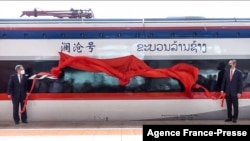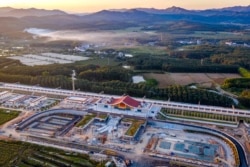Chinese and Lao officials Friday inaugurate a $5.9 billion high-speed rail line through Laos, six years after breaking ground on the first leg of Beijing’s grand plans to link China’s underdeveloped interior with the bustling seaports of Singapore by train.
The 414-kilometer ribbon of steel and concrete ties Laos’ northern border with China’s Yunnan province to its frontier with Thailand at Vientiane, Laos’ capital, across 167 bridges and 75 tunnels. With a top speed of 160 kilometers per hour, sleek new bullet trains will cut a bone-jarring 15-hour road trip down to under four hours, promising a new tide of trade and tourists from China for one of Southeast Asia’s poorest countries.
For Beijing, it is the critical opening move of a key Belt and Road Initiative project aimed at not only developing Yunnan by plugging it into some of Southeast Asia’s biggest economies but at pulling the region further into China’s orbit, analysts say.
“From a Chinese perspective it enables China to look at continental Southeast Asia as part of the hinterland, and they’ll have better control, they’ll have better access because the train is there,” said Ruth Banomyon, a professor at Thailand’s Thammasat University who studies international trade, transport and logistics.
Promise and peril
Laos is hoping the line will help transform the country from landlocked to land-linked, drawing more foreign holidaymakers and investors in while sending more of its own wares out.
“Trade between China and Laos is not a big volume and Laos being a landlocked country needs more points to be connected to the outside world, so potentially this could help Laos develop its economy in the … long run,” said Li Mingjiang, an associate professor at Singapore’s S. Rajaratnam School of International Studies.
Small farmers and producers, though, will only reap the benefits if Laos commits to building the roads they will need to connect with the new trains, Li added, “otherwise … the railway will only be a transit line” that passes them by.
Pon Souvannaseng, an assistant professor of global studies at Bentley University in the United States, said railway projects driven by foreign interests have a history of doing more harm than good for countries like Laos, saddling the hosts with the costs while siphoning out the profits.
She said China, in particular, sees its BRI corridors as opportunities first and foremost to export its own labor, goods, credit and capital, taking little care to develop supply chains with the potential to spur more and better jobs in host countries.
“Essentially, you’re opening up an undeveloped market … that is surrounded by two huge world manufacturing hubs, Thailand and China. So, Laos is not the beneficiary but they’re literally footing the bill,” she said of the new line.
Laos has committed to covering 30% of the project’s $5.9 billion price tag, much of it with loans from China backed up with land and natural resources as collateral. Combined with what it has borrowed from China for other projects, Laos has triggered fears of a looming debt default and warnings that Beijing is gaining too much sway over the country.
“The railway project and other Chinese investments in Laos are creating a situation in which Laos [is] increasingly more dependent on China economically, and that will to some extent translate into China’s political and economic influence over Laos, that’s for sure,” said Li.
Laos and beyond
Pon said the completion of the high-speed railway through Laos was proof that the country was firmly in Beijing’s orbit already, having overcome both political opposition in Laos and doubts about its commercial viability in China over the past decade.
“It was an unlikely project,” she said. “So, for it to exist now, and for all the positive, flowery language to come out from the Lao side, it speaks to the geopolitical completion of that relationship.”
With the railway’s leg through Laos now complete, Beijing can focus its attention on seeing the rest of the line through.
“Going through Laos is just the first step because Laos in itself doesn’t have much to offer [China] apart from some agricultural produce and probably some mining goods such as copper,” said Ruth. “To really benefit from it is to be able to get access into Thailand [and] to link with Malaysia so that they have access to the whole of continental Southeast Asia.”
Work on isolated sections of the line is already underway in Thailand and Malaysia, though both countries are proving tougher bargaining partners for China than Laos.
Malaysia froze construction on the line in 2018 over cost concerns and only started up work again the following year after convincing China to slash the original $20 billion price tag by about a third. In Thailand, after more than 30 rounds of negotiations over several years, the government has thus far approved construction on less than a third of the line due to run from the country’s border with Laos to the capital, Bangkok.
Ruth said Thailand was keen on the project but, unlike Laos, has the bargaining power to insist on better terms with Beijing so as to avoid the debt trap risks roiling some of China’s other BRI partners.
He believes, though, that China’s high-speed railway push through Southeast Asia will continue.
“The juggernaut has already started moving,” he said, “so it will not stop.”





